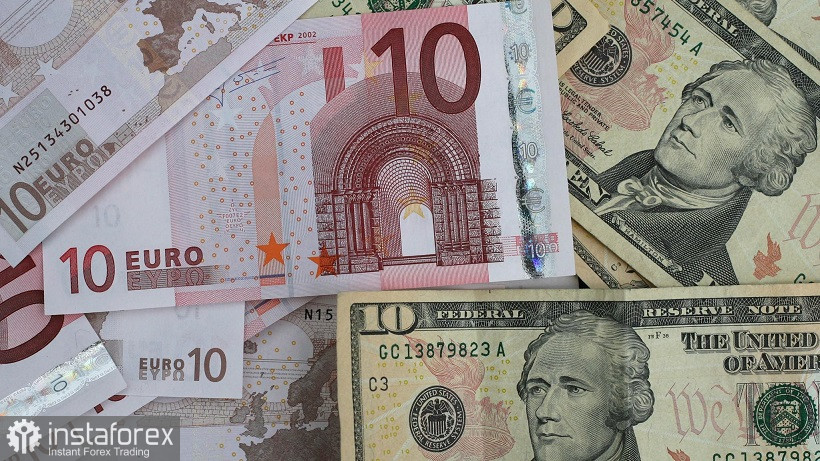The euro-dollar pair declined to the base of the 4th figure yesterday, updating the four-week price low at 1.0401. However, traders did not storm the borders of the third price level: the sellers of EUR/USD recorded profits and thereby extinguished a fairly strong downward impulse. Today, buyers are trying to win back some of the lost positions. The corrective price increase looks quite logical after a prolonged consecutive decline. Just last Thursday, the pair was approaching the 1.0800 mark, trying to gain a foothold above the 1.0760 resistance level. But after the publication of the inflation report in the US, market sentiment changed dramatically in favor of the US currency.
The oil market also added fuel to the fire, which has again perked up against the backdrop of the global energy crisis. The dollar has become the beneficiary of the current situation, so the current corrective growth of EUR/USD should be treated with great caution.

Brent crude oil crossed the $123 mark yesterday, after which the US dollar index updated an almost 20-year high, rising to the area of 105 points. This is the highest value since December 2002. Oil pulls the greenback, as a further increase in energy prices will contribute to an increase in inflation, forcing the Federal Reserve to act more decisively and aggressively. In turn, the oil market is strengthening its position against the background of disappointing news from Libya.
According to Bloomberg, oil production in Libya has almost stopped due to political strife within the country. The rate of decline is impressive: if in 2021 the daily production rate was at the level of 1.2 million barrels, now it has dropped to 100,000. The 1.1 million bpd that fell out account for about one percent of the total global production. A long-simmering political crisis has flared up again in the country, which has worsened this year amid high inflation.
Last week, OPEC+ representatives decided to increase oil production quotas by 648,000 bpd (in July and August) instead of the previously planned increase by 432,000 bpd. After the announcement of this decision, the oil market sank somewhat, but recovered quickly enough: oil traders came to the conclusion that such a step would not reverse the situation as a whole. According to some estimates, in the third quarter, the global oil deficit will average 400,000 bpd. The easing of quarantine restrictions in China, as well as the start of the so-called automobile season in the United States and Europe, will continue to spur oil prices.
The rise in the price of oil will contribute to the growth of inflation, forcing the Fed to act more decisively. At the June meeting, the Fed may strengthen its hawkish rhetoric by announcing a rate hike in 50-point increments at each meeting until the end of the year. Note that at the end of last month, consumer prices in the US jumped to 8.6% (from the April value of 8.3%) YoY. This is the highest value since December 1981. The April result signaled a slowdown in growth, whereas in May, most experts predicted that the indicator would remain at the level of the previous month. But in reality, inflation has shot up again, puzzling market participants, and most likely, members of the Fed.
Today, EUR/USD buyers decided to take advantage of the situation by organizing a small corrective counteroffensive. The formal reason for the rise in prices was the release of data on the growth of German inflation. The consumer price index in the country jumped to 7.9%. This is a new historical anti-record for a united Germany. A similar level of inflation was observed in Germany at the junction of 1973 and 1974 against the background of a sharp rise in oil prices due to the oil crisis.
However, despite such impressive growth rates of German inflation, the EUR/USD pair did not leave the area of the 4th figure as part of the corrective growth. Traders reasonably doubt that the European Central Bank will change the trajectory of rate hikes (0.25% in July and 0.25% in September) in the direction of acceleration. Therefore, the market reaction to today's data was restrained and rather formal. Moreover, following the inflation data, ZEW indices were published, which turned out to be in the "red zone." In particular, the index of economic sentiment in Germany remained deep in the negative area, reaching -28 points.
Thus, it is advisable to use the current corrective pullback as an excuse to open short positions: the fundamental background is in favor of further strengthening of the US currency. The dark horse here is the Fed, which will announce the results of its June meeting tomorrow evening. But on the eve of this event, traders are unlikely to take risks and play against the greenback. Therefore, in the next 24 hours, EUR/USD bears may again test the support level of 1.0400, which corresponds to the lower line of the Bollinger Bands indicator on the daily chart.





















